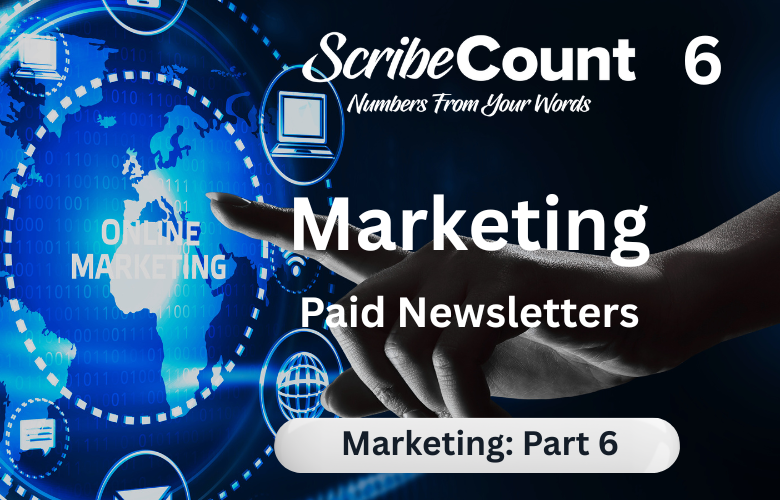Paid Newsletters for Indie Authors
In the increasingly crowded world of indie publishing, visibility is everything. Great books don’t sell if no one sees them—and for independent authors without a massive platform, getting noticed can be a challenge. That’s where paid newsletters come in. These curated email blasts reach hundreds of thousands of eager readers actively looking for their next great read. With strategic timing and genre alignment, these newsletters can supercharge ebook downloads, audiobook sales, and even print discoverability.
Paid newsletter promotions have become a cornerstone of book marketing for indie authors. Whether launching a new title, boosting a backlist, or stacking a promotional campaign around a price drop, these services offer immediate visibility and measurable results. For many authors, they’re not just a one-time tactic—they’re a repeatable, scalable part of a long-term publishing strategy.
This article provides an in-depth look at how paid newsletter promotions work, which services are most effective, and how indie authors are using them across formats—ebooks, print, and audio. It includes platform comparisons, pricing, prerequisites, step-by-step execution strategies, and proven methods for combining services into a coordinated launch or promo. From BookBub to Freebooksy to niche genre sites, this is your complete guide to paid newsletters as a marketing tool.
What Are Paid Book Promotion Newsletters?
At their core, paid newsletters are email lists managed by promotional services that send out curated deals to subscribers. These subscribers sign up voluntarily, often by genre preference, and receive daily or weekly emails featuring discounted or free books that match their interests. Indie authors pay a fee to have their book included, usually tied to a temporary price drop.
What makes these newsletters powerful is the intent of their audience. These are readers who want to discover new books. They’re not being interrupted on social media or distracted by video ads—they’re opening an email because they’re actively shopping for their next read. For authors, that translates into higher click-through rates, more downloads, more page reads in Kindle Unlimited, and—if the book is good—more long-term fans.
Each service maintains its own standards, pricing, genres, and submission process. Some focus on deep discounts or freebies, others on full-priced or boxed sets. Many now include audiobooks, print editions, and even direct store links. These newsletters can be used alone or stacked in a coordinated push to amplify results over several days or weeks.
BookBub: The Gold Standard of Paid Promotions
BookBub is the most powerful and sought-after paid newsletter in publishing. With over 20 million readers globally and unmatched reach in genres like romance, mystery, thrillers, fantasy, and historical fiction, a single BookBub Featured Deal can generate thousands of downloads in a single day.
BookBub promotions are curated. Authors must submit their book for consideration and meet strict criteria. This typically includes a professional cover, positive reviews, a discounted price (often $0.99 or free), and genre alignment with reader demand. Acceptance rates are low, but for those who land a slot, the results can be exceptional.
BookBub also offers Chirp for audiobook promotions, which mirrors the same model—curated deals sent to audio listeners, often in partnership with Findaway Voices or Authors Direct. Chirp allows discounted audiobook promotions without requiring Audible exclusivity.
Cost for a BookBub Featured Deal varies by genre and region, ranging from $100 for smaller categories to over $1,000 for a U.S. promotion in high-demand genres like thrillers or contemporary romance. Despite the price, many authors report a strong return on investment, especially when promoting the first in a series.
Authors can also use BookBub Ads, a self-serve display ad platform targeting readers by author interest or genre. These are different from Featured Deals and can be tested year-round, though they require ad copywriting and design strategy.
Successful authors use BookBub as the anchor of a price-drop campaign, coordinating newsletter swaps, social content, and supplemental promos around the same week. It remains the most influential tool in the indie author’s promo arsenal.
Written Word Media: Affordable Reach and Genre Flexibility
Written Word Media is home to a suite of popular newsletters, including Freebooksy, Bargain Booksy, Red Feather Romance, NewInBooks, and AudioThicket. Together, these lists reach millions of readers across various genres and formats.
What sets Written Word Media apart is accessibility. Unlike BookBub’s competitive curation, most of these lists operate on a paid submission model—meaning if your book meets the basic requirements, you can schedule a promo directly. This makes them ideal for first-time authors or backlist books that need a visibility boost.
Freebooksy is focused entirely on free ebook promotions and works best in volume-based strategies, where large numbers of downloads fuel email list growth or series read-through. Bargain Booksy handles discounted titles ($0.99–$2.99), and is often used for boxed sets, limited-time deals, or countdown campaigns.
AudioThicket serves audiobook readers and pairs well with Chirp, especially when running price promos across platforms like Spotify, Apple, and Authors Direct. Red Feather Romance is WWM’s romance-only list and offers premium placement for spicy and sweet romance subgenres.
Pricing for these services varies by genre and list size. Freebooksy starts around $40 per promo, while Bargain Booksy ranges from $45 to $100. Red Feather Romance and AudioThicket are similarly priced. Bundle packages allow authors to combine multiple promos across different services for added exposure.
Written Word Media provides excellent customer service and allows authors to target specific audiences with ease. Their platforms are especially effective for stacking promotions or driving long-tail sales when layered with BookBub Ads or retailer promotions.
The Fussy Librarian: Budget-Friendly Niche Targeting
The Fussy Librarian is a low-cost alternative that allows authors to promote free or discounted books to segmented lists based on genre and content tags. The platform is known for its flexibility and straightforward booking system.
With a readership in the hundreds of thousands, The Fussy Librarian’s reach is smaller than BookBub or Freebooksy, but still meaningful—especially when layered with other promos. Pricing is highly affordable, typically between $20–$35 depending on genre and price point.
What makes The Fussy Librarian unique is its openness to new authors, smaller niche genres, and international markets. Authors who struggle to land placements on premium newsletters often find traction here, particularly in cozy mysteries, Christian fiction, or nonfiction subcategories.
This platform works well for authors running extended promos, offering visibility boosts before or after a major campaign. It’s often used to round out a launch or as a reliable backlist boost.
Robin Reads: Romance and Mystery Powerhouse
Robin Reads focuses on fiction and reaches a large reader base that leans heavily toward romance, mystery, and thrillers. Like BookBub, Robin Reads is curated—authors must submit their books and wait for acceptance, but the criteria are less rigid.
Robin Reads offers highly targeted lists and reports strong open rates. Its strength lies in reader engagement rather than pure volume, making it a good complement to larger promotions. A typical promotion costs $65–$85, and accepted authors often see 300–1,000+ downloads in a single day.
For authors writing in commercial genres with good covers and reviews, Robin Reads can be a powerful tool. It pairs well with BookBub Ads, Freebooksy, or Amazon countdown deals, helping authors hit rank thresholds or trigger algorithms with a surge of reader traffic.
eReaderIQ and Genre-Specific Sites
eReaderIQ aggregates price drops from Amazon and maintains a subscriber base interested in daily deals. While not a paid newsletter in the traditional sense, authors can use its free listing tools to notify readers of discounts. When combined with a Kindle Countdown Deal, this can provide free visibility in a price-sensitive audience.
Other genre-specific sites—like Book Rebel for thrillers, Book Cave for clean reads, and ManyBooks for wide distribution—offer paid newsletter services with their own audiences and pricing models. These platforms serve as excellent supplements for authors in specific niches.
Print and Audiobook Promotions Through Paid Newsletters
While most paid newsletters focus on ebooks, an increasing number are expanding into audio and print. Chirp, AudioThicket, and Authors Direct offer audiobook promos, especially for authors who use Findaway Voices or Spotify for Authors.
For print, the focus is usually indirect. Newsletters drive readers to Amazon or wide retailer pages where print editions are available alongside ebooks. Authors with strong print sales—such as children’s authors or nonfiction writers—can benefit from driving general traffic and capturing print orders organically.
When submitting for promotion, ensure your print and audiobook editions are linked correctly in retailer metadata. This helps readers discover the format they prefer and increases your potential return.
How to Execute a Paid Newsletter Campaign
A successful campaign begins with a clear goal. Are you launching a new release, boosting a backlist, increasing sell-through in a series, or building your email list? Your objective determines your pricing strategy, timing, and newsletter selection.
Start by scheduling your price drop. For Amazon exclusives, Kindle Countdown Deals or Free Promotions are ideal. For wide books, coordinate price changes across all platforms, including Kobo, Apple Books, and Barnes & Noble. Use a tool like Books2Read for a universal link and ScribeCount to monitor sales across platforms.
Next, book your newsletter slots. For best results, stack promotions over three to five days. For example, run Freebooksy on Monday, Robin Reads on Tuesday, and Fussy Librarian on Wednesday. Add BookBub Ads throughout the week for sustained impressions.
Prepare your assets in advance—metadata, book links, author photo, and sample ad copy. Follow submission guidelines carefully. Some platforms require five-star reviews, others a minimum page count or genre tag. Submit early, as slots fill quickly, especially during peak seasons.
Coordinate your own marketing around the same window. Send email blasts to your list, schedule social posts, and consider bonus content like author Q&As, livestreams, or giveaways to extend engagement.
Track your performance using ScribeCount, your ad dashboards, and individual platform reporting. Log your results and ROI to refine your strategy for future campaigns.
Combining Platforms for Greater Impact
The most effective authors treat paid newsletters as part of a holistic launch or promo strategy. By combining multiple services, they extend visibility, reach new segments of readers, and build sustained momentum that fuels platform algorithms.
A well-coordinated campaign might begin with Freebooksy and Fussy Librarian, build into a Robin Reads mid-week push, peak with a BookBub Featured Deal, and then taper with BookBub Ads and social retargeting. For audiobooks, they might add Chirp or AudioThicket on the final day.
The stacking effect not only boosts sales—it drives reviews, subscriber growth, and series sell-through. When used consistently, these services help authors maintain a strong release cadence, reawaken old books, and connect with fresh readers every month.
Final Thoughts: Investing in Discoverability
Paid newsletter promotions are not a shortcut to success—but they are one of the most dependable, measurable, and scalable marketing tools available to indie authors. When used strategically, they offer a powerful return on investment and help authors build lasting visibility across formats and platforms.
Like any tool, they work best when paired with strong fundamentals: a great book, professional packaging, a solid author brand, and a growing email list. With those pieces in place, paid newsletters can become the foundation of an evergreen marketing strategy—one that fuels both launches and long-term sales.
As the publishing landscape continues to evolve, one truth remains: readers still find books through trusted recommendations. Paid newsletters deliver those recommendations at scale—day after day, book after book, author after author.

